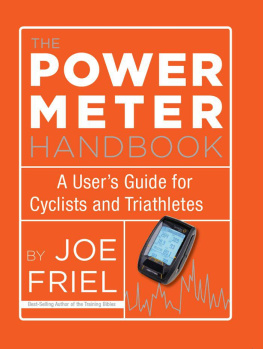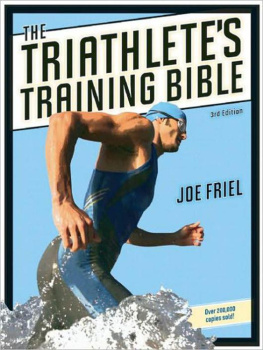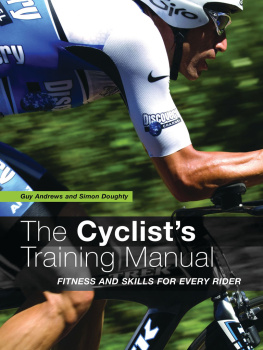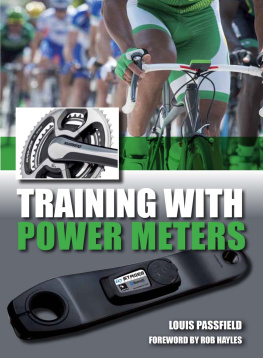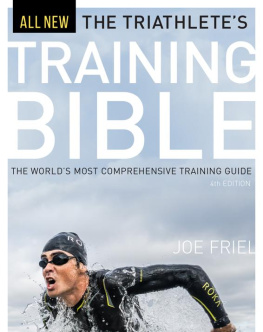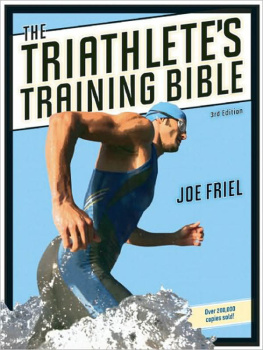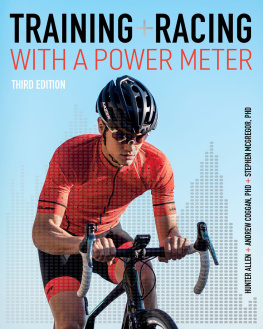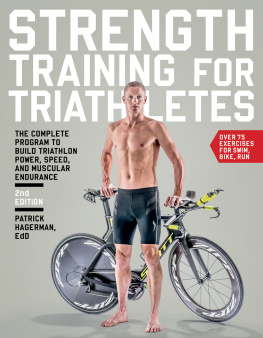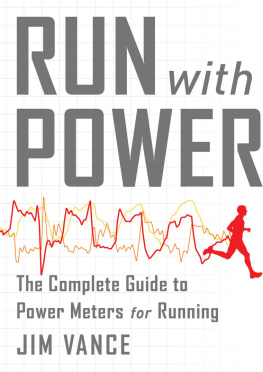| The Power Meter Handbook: A Users Guide for Cyclists and Triathletes |
| Friel, Joe |
| Ingram Distribution (2012) |
|


Copyright 2012 by Joe Friel
All rights reserved. Published in the United States of America by VeloPress, a division of Competitor Group, Inc..
Ironman is a registered trademark of World Triathlon Corporation. Acute Training Load, Chronic Training Load, Intensity Factor, Normalized Power, Performance Management Chart, Training Stress Score, and Variability Index are trademarks of Peaksware, LLC.

3002 Sterling Circle, Suite 100
Boulder, Colorado 80301-2338 USA
(303) 440-0601 Fax (303) 444-6788 E-mail
Distributed in the United States and Canada by Ingram Publisher Services
A Cataloging-in-Publication record for this book is available from the Library of Congress.
ISBN 978-1-934030-95-0 (paperback); ISBN 978-1-937716-19-6 (e-book)
For information on purchasing VeloPress books, please call (800) 811-4210, ext. 2138, or visit www.velopress.com.
Cover and interior design by Heidi Carcella
Cover photograph by Brad Kaminski; screen image courtesy of CycleOps
Power chart illustrations adapted by Charles Chamberlin
Version 3.1
CONTENTS
WHY DO YOU TRAIN? Before you answer that question, I want to make sure were talking about the same thing. You will come across the words train and training often in this book. They are common in an athletes vocabulary. What I mean when using them here is working out with a purpose. That purpose is to improve performance. In this book, performance has to do with a bike-related event, such as a triathlon, road race, time trial, mountain bike race, or century ride.
Lets drill down a little deeper. By performance, Im talking about riding competitivelypreparing to become fitter and therefore faster in order to improve on your previous results in similar events or to finish high in your event category. Some athletes compete with others, while some compete only with themselves by trying to improve on previous performances. Either is fine. Both require purposeful workouts to produce greater fitness.
If the workout purpose is not bike performanceif, for example, its losing weight or improving health, both of which are worthy goalsthen its exercise, not training, to my way of thinking. Power meters can be useful for any of these desired results. But the purpose well be examining in great detail here is trainingpurposeful workouts intended to produce better event performance.
The power meter is a powerful tool for training, one that can potentially make you fitter and faster than any other piece of equipment you could get for your bike. Even if you have been in the sport for a long time and achieved all the fitness you think is possible, I guarantee that you have room for improvement. Ive coached athletes who have gone from years of middle-of-the-pack finishes to the podium within one season after starting to train with a power meter. Im certain you can, also. The upper limit of potential for performance in sport is remarkably high and largely untapped by almost all athletes. This is where a power meter can make a difference.
You may know of someone who has a power meter but has never really seen any significant improvement in performance because of it. Thats common. Power meters are not magic. You dont just put one on your bike and all of a sudden become faster. When you begin using one for the first time, it looks simple enoughjust a number on your handlebars that changes as you go harder or easier. And you might find yourself thinking, Whats the big deal? Ive heard that from new power meter owners a lot. The numbers are interesting, but so what? Its not until you begin to look at the downloaded data with your computer software that the magic happensif you know what all the numbers mean. If youve looked at the data after a ride, then you know what Im talking about. It can be a bit overwhelming. That ever-changing flow of numbers you saw on your handlebars during the ride has somehow morphed into graphs, tables, and charts. What does it all mean? How is it going to make you fitter and faster?
For now youre just going to have to take my word that it will. But after reading and applying the basic concepts in this book, youll see change. Your new power meter will help you become a better rider. Well get into the details of how to do that in subsequent chapters. First, lets look at what the power meter can do to improve your performance and why its better than any other training tool.
To become fitter and faster, you need to make physical and perhaps even mental changes as you prepare for an event. Your power meter can help you do both. Here are five performance-enhancing ways that a power meter can improve your training once you know how to use it.
Make Training Precisely Match the Demands of the Race
This is undoubtedly the most important reason for using a power meter. Effective training demands precision for you to become more fit. The obvious question is Fit for what? Every high-performance event, whether its a 6-hour Ironman triathlon ride or a 45-minute criterium, demands a specific type of fitness. This comes down to getting the duration and intensity of the key workouts right. Duration is easy. A stopwatch or an odometer will do. But intensity is a different story and raises some very important issues for your training.
The first intensity issue has to do with the specific demands of the goal event. How intensein other words, how hardwill it be? Some events, the 6-hour Ironman ride, for example, require you to put out a steady but relatively low intensity for a long time. In contrast, the 45-minute criterium race fluctuates between extremely high and low intensities. Training with the same intensity for both of these events simply wont work. Your key workouts must reflect the exact levels of intensity demanded by the event in order for you to become fit for it.
Without a power meter, youre just guessing at how hard to make your key workouts. If you guess wrongeither too high or too lowyoull have a poor performance. With a power meter, youll know exactly what the intensity demands of the event are so that you can replicate them in training. Then over the course of a few weeks, you can make your workouts increasingly like the goal event by training at the precise intensities needed. On race day there will be no surprises. Your body will be ready to meet the demands of the event.
Pace Steady-State Races
To be successful in steady-state events such as time trials and triathlons, you must expend your energy in a well-calculated manner. This is called pacing. Its hard to get right, even for seasoned veterans of the sport. Most go out much too fast at the start and pay the price in the second half of the race by significantly slowing down. This is the most common mistake made in steady-state events. I see it happen in every race. It can be easily fixed with a power meter in a much more precise manner than with a heart rate monitor. In fact, your heart rate monitor is probably setting you up for poor race pacing. (You may be shaking your head at that idea, but its true. Ill come back to it later in this chapter to explain why.)

